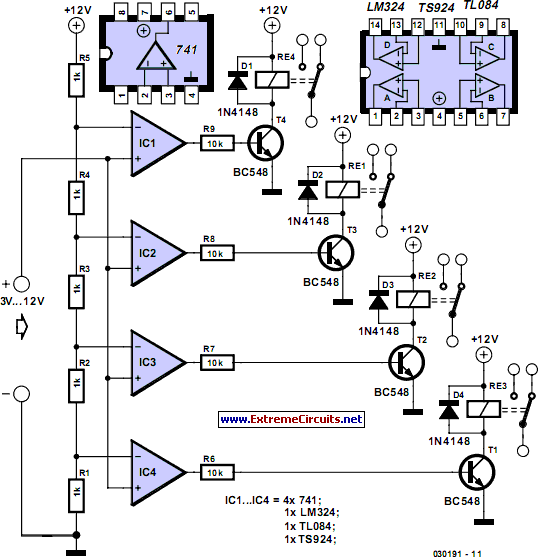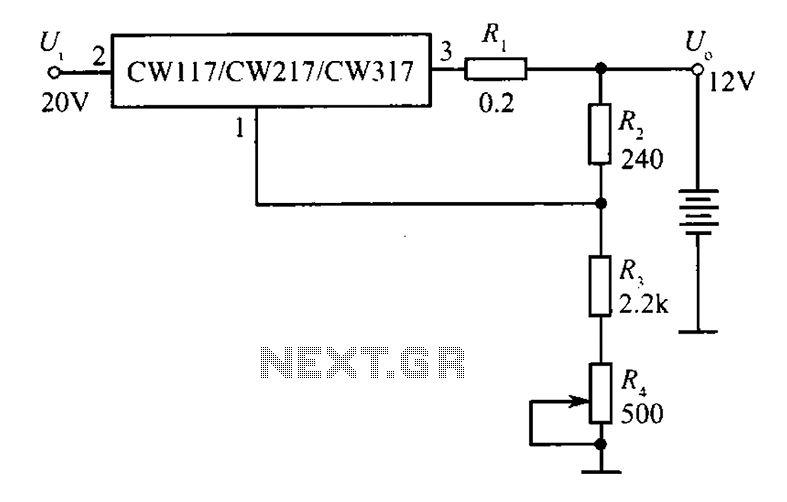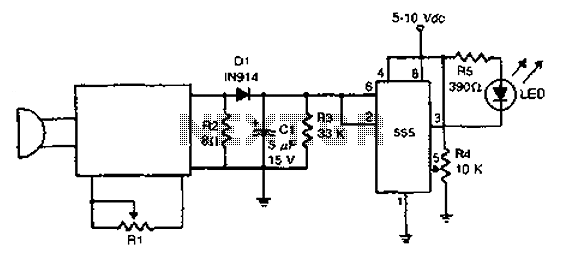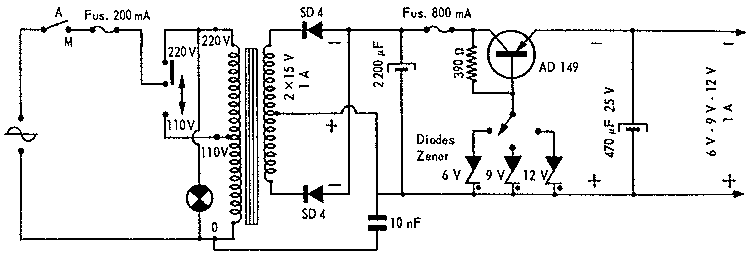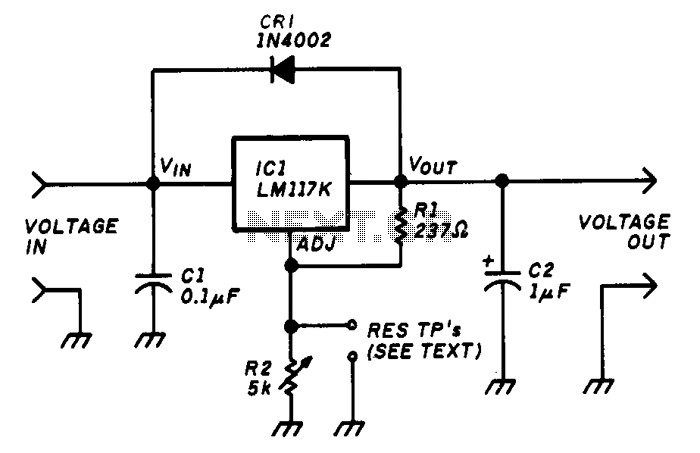
voltage level indicator

The circuit possesses significant educational value. It has not been tested. Users can simulate and test it or construct it to evaluate its performance. The circuit functions as a simple analog-to-digital converter. Optocouplers can be used in place of LEDs. Transistors T1 and T2 form a differential amplifier, while T3, T4, and T5 serve as comparators driving the LEDs. To gain further understanding of their operation, it is recommended to study circuits at 4QD-TEC and search for resources on Educypedia. Additional ideas can be found on PSpice and 101Science.com. As the input voltage increases, T1 is activated, leading to increased base current for T3, which illuminates LED1. Conversely, when the input voltage decreases, T2 becomes active as it receives a greater base current from P3, turning on LED2 via T4. When both LEDs are off, T5 is biased due to no voltage drop across R5, which ideally lights LED3 through T5. It is important to note that a small base current (Ib) through the base-emitter junction will result in a larger collector current (Ic) through the emitter-collector path, expressed as Ic = B * Ib, where B (beta) represents the DC current gain, typically ranging from 100 to 400. The beta value varies among different transistors and is influenced by test conditions, temperature, and age. LED1 and LED2 indicate whether the input voltage is above or below the limits set by P2 and P1, respectively. The limit threshold is established at P3. LED3 activates when both LED1 and LED2 are off. Potential applications of this circuit include FM tuning indicators, stereo balance indicators (by wiring T2 similarly to T1 for dual-channel inputs), and battery level indicators.
The circuit operates as a basic analog-to-digital converter, leveraging the characteristics of bipolar junction transistors (BJTs) to compare input voltage levels. The differential amplifier configuration formed by transistors T1 and T2 provides a means to amplify the difference between two input signals. This is essential for determining whether the input voltage exceeds predefined thresholds.
Transistors T3 and T4 act as comparators, responding to the amplified signals from T1 and T2. When the input voltage surpasses the threshold set by potentiometer P2, T3 conducts, allowing current to flow through LED1, signaling that the input is above the limit. Conversely, if the input voltage falls below the threshold defined by potentiometer P1, T2 activates, allowing T4 to illuminate LED2, indicating that the input is below the limit.
The behavior of T5 is crucial for indicating the state when both input conditions are unmet. In this scenario, T5 is biased due to the absence of voltage drop across resistor R5, allowing LED3 to light up, indicating a neutral condition where neither threshold is exceeded.
The circuit's design incorporates feedback mechanisms that enhance stability and responsiveness to input changes. The use of variable resistors (P1, P2, and P3) allows for fine-tuning of the thresholds, making the circuit adaptable to various applications. The beta parameter of the transistors, which indicates their current amplification capabilities, is a critical factor in ensuring reliable operation. Variations in beta due to manufacturing differences and environmental factors must be accounted for during circuit design and testing.
In summary, this circuit serves multiple applications, including FM tuning, stereo balance adjustment, and battery level monitoring, providing a versatile tool for educational and practical purposes in electronics.The circuit is here as it is of high educational value. I have not tested it. You can `simulate and test` or `wire it up and try` and let me know how it worked. The Circuit is also a simple analog to digital converter. You can use optos in place of LEDs. T1 and T2 make a differential amplifier. T3, T4 and T5 driving the LEDs are comparators. Now t o learn more on how they work you have to study circuits at 4QD-TEC and search Educypedia for more. Some pspice ideas here and at 101Science. com. When input voltage is increased T1 is turned on which leads to more base current for T3 which Lights LED1. When input voltage is less T2 turns on as it gets a better base current from P3 which turns on LED2 via T4.
When both LEDs are off T5 gets biased as no drop across R5 which lights the LED3 thru T5 hopefully. What you need to know is a small current Ib thru the base-emitter path in the direction of the emitter arrow will lead to a large Current Ic thru the emitter-collector path in direction of arrow. Ic = B * Ib where B - beta is the DC current gain, it could be 100-400 see Towers International Transistor Selector see chipdir.
Beta is different in each transistor you buy and varies with the test conditions and even with temperature and age. The LED1 and LED2 will indicate above or below Limits set by P2 and P1. The Limit Threshold itself is set at P3 i think. LED3 will light when Hi LED and Lo LED both are off. The applications of this circuit are FM tuning indicator, Stereo Balance Indicator (Wire T2 like T1 then we get two channel inputs) and battery level indicator.
🔗 External reference
The circuit operates as a basic analog-to-digital converter, leveraging the characteristics of bipolar junction transistors (BJTs) to compare input voltage levels. The differential amplifier configuration formed by transistors T1 and T2 provides a means to amplify the difference between two input signals. This is essential for determining whether the input voltage exceeds predefined thresholds.
Transistors T3 and T4 act as comparators, responding to the amplified signals from T1 and T2. When the input voltage surpasses the threshold set by potentiometer P2, T3 conducts, allowing current to flow through LED1, signaling that the input is above the limit. Conversely, if the input voltage falls below the threshold defined by potentiometer P1, T2 activates, allowing T4 to illuminate LED2, indicating that the input is below the limit.
The behavior of T5 is crucial for indicating the state when both input conditions are unmet. In this scenario, T5 is biased due to the absence of voltage drop across resistor R5, allowing LED3 to light up, indicating a neutral condition where neither threshold is exceeded.
The circuit's design incorporates feedback mechanisms that enhance stability and responsiveness to input changes. The use of variable resistors (P1, P2, and P3) allows for fine-tuning of the thresholds, making the circuit adaptable to various applications. The beta parameter of the transistors, which indicates their current amplification capabilities, is a critical factor in ensuring reliable operation. Variations in beta due to manufacturing differences and environmental factors must be accounted for during circuit design and testing.
In summary, this circuit serves multiple applications, including FM tuning, stereo balance adjustment, and battery level monitoring, providing a versatile tool for educational and practical purposes in electronics.The circuit is here as it is of high educational value. I have not tested it. You can `simulate and test` or `wire it up and try` and let me know how it worked. The Circuit is also a simple analog to digital converter. You can use optos in place of LEDs. T1 and T2 make a differential amplifier. T3, T4 and T5 driving the LEDs are comparators. Now t o learn more on how they work you have to study circuits at 4QD-TEC and search Educypedia for more. Some pspice ideas here and at 101Science. com. When input voltage is increased T1 is turned on which leads to more base current for T3 which Lights LED1. When input voltage is less T2 turns on as it gets a better base current from P3 which turns on LED2 via T4.
When both LEDs are off T5 gets biased as no drop across R5 which lights the LED3 thru T5 hopefully. What you need to know is a small current Ib thru the base-emitter path in the direction of the emitter arrow will lead to a large Current Ic thru the emitter-collector path in direction of arrow. Ic = B * Ib where B - beta is the DC current gain, it could be 100-400 see Towers International Transistor Selector see chipdir.
Beta is different in each transistor you buy and varies with the test conditions and even with temperature and age. The LED1 and LED2 will indicate above or below Limits set by P2 and P1. The Limit Threshold itself is set at P3 i think. LED3 will light when Hi LED and Lo LED both are off. The applications of this circuit are FM tuning indicator, Stereo Balance Indicator (Wire T2 like T1 then we get two channel inputs) and battery level indicator.
🔗 External reference
